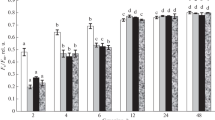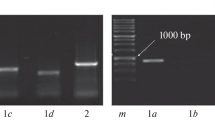Abstract
Using Real-time PCR, the regulation of gene expression for proteins involved in alternative and uncoupled respiration in tomato (Lycopersicon esculentum Mill.) seedlings and cell culture was studied. The temperature of 4°C activated transcription of these genes. The effect of low temperature on the activities of a number of enzymes involved in oxidative metabolism of seedlings and cultivated cells was detected by spec-trophotometric methods. When oxidative stress in tomato cell culture was created by treatments with hydrogen peroxide and antimycin A, it was established that the mRNA levels of the alternative oxidase, the uncoupling protein, and the ATP/ADP antiporter were controlled by ROS, and this may be the mechanism of “free” oxidation induction during cold stress adaptation.
Similar content being viewed by others
Abbreviations
- AO:
-
alternative oxidase
- BA:
-
benzyladenine
- MDH:
-
malate dehydrogenase
- MS:
-
Murashige and Skoog nutrient medium
- NBT:
-
nitro blue tetrazolium
References
Semikhatova, O.A., Maintenance Respiration and the Cost of Plant Adaptation, Russ. J. Plant Physiol., 1995, vol. 42, pp. 277–284.
Armstrong, A.F., Badger, M.R., Day, D.A., Barthet, M.M., Smith, P.C., Millar, A.H., Whelan, J., and Atkin, O.K., Dynamic Changes in the Mitochondrial Electron Transport Chain Underpinning Cold Acclimation of Leaf Respiration, Plant Cell Environ., 2008, vol. 31, pp. 1156–1169.
Szal, B., Lukawska, K., Zdolinska, I., and Rychter, A.M., Chilling Stress and Mitochondrial Genome Rearrangement in the MSC16 Cucumber Mutant Affect the Alternative Oxidase and Antioxidant Defense System to a Similar Extent, Physiol. Plant., 2009, vol. 137, pp. 435–445.
Popov, V.N., Albert, C.P., Skulachev, V.P., and Wagner, A.M., Stress-Induced Changes in Ubiquinone Concentration and Alternative Oxidase in Plant Mitochondria, BioSci. Rep., 2001, vol. 21, pp. 369–379.
Bertsova, Yu.V., Popov, V.N., and Bogachev, A.V., NADH Oxidation by Mitochondria from the Thermogenic Plant Arum orientale, Biochemistry (Moscow), 2004, vol. 69, pp. 580–584.
Wagner, A.M., A Role for Active Oxygen Species as Second Messengers in the Induction of Alternative Oxidase Gene Expression in Petunia hybrida Cells, FEBS Lett., 1995, vol. 368, pp. 339–342.
Minagawa, N., Koga, S., Nakano, M., Sakajo, S., and Yoshimoto, A., Possible Involvement of Superoxide Anion in the Induction of Cyanide-Resistant Respiration in Hansenula anomala, FEBS Lett., 1992, vol. 302, pp. 217–219.
Parkin, K.L., Marangoni, A., Jackman, R., Yada, R., and Stanley, D., Chilling Injury: A Review of Possible Mechanisms, Food Biochem., 1989, vol. 13, pp. 127–153.
Popov, V.N., Possible Role of Free Oxidation Processes in the Regulation of Reactive Oxygen Species Production in Plant Mitochondria, Biochem. Soc. Trans., 2003, vol. 31, pp. 1316–1317.
Korshunov, S.S., Skulachev, V.P., and Starkov, A.A., High Protonic Potential Actuates a Mechanism of Production of Reactive Oxygen Species in Mitochondria, FEBS Lett., 1997, vol. 416, pp. 15–18.
Vianello, A., Petrussa, E., and Macri, F., ATP/ADP-Antiporter Is Involved in Uncoupling of Plant Mitochondria Induced by Low Concentrations of Palmitate, FEBS Lett., 1994, vol. 349, pp. 407–410.
Popov, V.N., Markova, O.V., Mokhova, E.N., and Skulachev, V.P., Effects of Cold Exposure In Vivo and Uncouplers and Recouplers In Vitro on Potato Tuber Mitochondria, Biochim. Biophys. Acta, 2002, vol. 1553, pp. 232–237.
Vercesi, A.E., Martins, I.S., Silva, M.A.P., Leite, H.M.F., Cuccovia, I.M., and Chaimovich, H., PUMP in Plants, Nature, 1995, vol. 375, p. 24.
Skulachev, V.P., Role of Uncoupled and Non-Coupled Oxidations in Maintenance of Safely Low Levels of Oxygen and Its One-Electron Reductants, Quart. Rev. Biophys., 1996, vol. 29, pp. 169–202.
Tsyrenov, V.Zh., Osnovy biotekhnologii: Kul’tivirovanie izolirovannykh kletok i tkanei rastenii (Basics of Biotechnology: Plant Cell and Tissue Cultures), Ulan-Ude: Vses. Gos. Techn. Univ., 2003.
Eprintsev, A.T. and Fedorina, O.S., Functioning of Malate Dehydrogenase System in Mesophyll and Bundle Sheath Cells of Maize Leaves under Salt Stress Conditions, Russ. J. Plant Physiol., 2007, vol. 54, pp. 728–735.
Fomenko, O.Yu., Distribution of Pathways for Free Oxidation of Respiratory Substrates and Regulation of Their Expression in Higher Plant Mitochondria, Cand. Sci. (Biol.) Dissertation, Voronezh: Voronezh. Gos. Univ., 2007.
Zemlyanukhin, A.A. and Zemlyanukhin, L.A., Bol’shoi praktikum po fiziologii i biokhimii rastenii (Workshop for Plant Physiology and Biochemistry), Voronezh: Voronezh. Gos. Univ., 1996.
Chevari, S., Chaba, I., and Sekei, I., Spectrophotometer Method for Superoxide Dismutase Determination, Lab. Delo, 1981, no. 11, pp. 678–680.
Nicot, N., Hausman, J.-F., Hoffmann, L., and Evers, D., Housekeeping Gene Selection for Real-Time RT-PCR Normalization in Potato during Biotic and Abiotic Stress, Exp. Bot., 2005, vol. 56, pp. 2907–2914.
Lakin, G.F., Biometriya (Biometrics), Moscow: Vysshaya Shkola, 1990.
Andersson, U., Leighton, B., Young, M.E., Blomstrand, E., and Newsholme, E.A., Inactivation of Aconitase and Oxoglutarate Dehydrogenase in Skeletal Muscle In Vitro by Superoxide Anions and/or Nitric Oxide, Biochem. Biophys. Res., 1998, vol. 249, pp. 512–516.
Svensson, A.S. and Rasmusson, A.G., Light-Dependent Gene Expression for Proteins in the Respiratory Chain of Potato Leaves, Plant J., 2001, vol. 28, pp. 73–82.
Skulachev, V.P., Why Are Mitochondria Involved in Apoptosis? Permeability Transition Pores and Apoptosis as Selective Mechanisms to Eliminate Superoxide-Producing Mitochondria and Cell, FEBS Lett., 1996, vol. 397, pp. 7–10.
Popov, V.N., Simonian, R.A., Skulachev, V.P., and Starkov, A.A., Inhibition of the Alternative Oxidase Stimulates H2O2 Production in Plant Mitochondria, FEBS Lett., 1997, vol. 415, pp. 87–90.
Author information
Authors and Affiliations
Corresponding author
Additional information
Original Russian Text © V.N. Popov, A.T. Eprintsev, E.V. Maltseva, 2011, published in Fiziologiya Rastenii, 2011, Vol. 58, No. 5, pp. 758–765.
Rights and permissions
About this article
Cite this article
Popov, V.N., Eprintsev, A.T. & Maltseva, E.V. Activation of genes encoding mitochondrial proteins involved in alternative and uncoupled respiration of tomato plants treated with low temperature and reactive oxygen species. Russ J Plant Physiol 58, 914–920 (2011). https://doi.org/10.1134/S1021443711040091
Received:
Published:
Issue Date:
DOI: https://doi.org/10.1134/S1021443711040091




